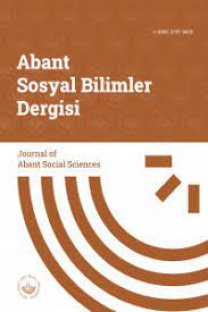ALGILANAN ELEKTRONİK WOM UNSURLARININ MARKA İMAJI VE SATIN ALMA NİYETİ ÜZERİNDEKİ ETKİLERİNİN İNCELENMESİ
Elektronik Ağızdan Ağıza iletişim (eWOM) Güvenirliği, eWOM Kalitesi, eWOM Niceliği, Marka İmajı, Satın Alma Niyeti.
EXAMINING THE EFFECTS OF PERCEIVED ELEKTRONIC WOM ELEMENTS ON BRAND IMAGE AND PURCHASE INTENTION
Electronic Word of Mouth (eWOM) Credibility, eWOM Quality, eWOM Quantity, Brand Image, Purchase Intention.,
___
- Ansary, A. and Hashim, N. M. H. N. (2018). Brand image and equity: The mediating role of brand equity drivers and moderating effects of product type and word of mouth, Review of Managerial Science, 12(4), 969-1002.
- Balroo, S. A. and Saleh, M. A. H. (2019). Perceived eWOM and Students’ University Enrolment Intentions: The Corporate Image as a Mediator, Journal of Economics, Management and Trade, 1-14.
- Bataineh, A. Q. (2015). The impact of perceived e-WOM on purchase intention: The mediating role of corporate image, International Journal of marketing studies, 7(1), 126.
- Chakraborty, U. and Bhat, S. (2018). The effects of credible online reviews on brand equity dimensions and its consequence on consumer behavior, Journal of promotion management, 24(1), 57-82.
- Cheung, C. M. and Thadani, D. R. (2010). The effectiveness of electronic word-of-mouth communication: A literature analysis, Proceedings of the 23rd Bled EConference ETrust: Implications for the Individual, Enterprises and Society, 329–345.
- Chen, Y. S. (2010). The drivers of green brand equity: Green brand image, green satisfaction, and green trust, Journal of Business ethics, 93(2), 307-319.
- Davis, D. F. - Golicic, S. L. - Marquardt, A. (2009). Measuring brand equity for logistics services, The International Journal of Logistics Management, 20(2), 201-212.
- Dou, X. - Walden, J. A. - Lee, S. - Lee, J. Y. (2012). Does source matter? Examining source effects in online product reviews, Computers in Human Behavior, 28(5), 1555-1563.
- Fan, Y. W. - Miao, Y. F. - Fang, Y. H. - Lin, R. Y. (2013). Establishing the adoption of electronic word-of-mouth through consumers’ perceived credibility, International Business Research, 6(3), 58.
- Fazli, M., Sam, M. and Tahir, M. N. (2009). Website Quality and Consumer Online Purchase Intention on Air Ticket, International Journal of Basic & Applied Sciences IJBASIJENS vol. 09 no. 10 , 4-9.
- Haşıloğlu, S. B., Baran, T. and Aydın, O. (2015). Pazarlama araştırmalarındaki potansiyel problemlere yönelik bir araştırma: Kolayda örnekleme ve sıklık ifadeli ölçek maddeleri, Pamukkale İşletme ve Bilişim Yönetimi Dergisi, (1), 19-28.
- Hennig-Thurau, T. and Walsh, G. (2003). Electronic word-of-mouth: Motives for and consequences of reading customer articulations on the internet, International Journal of Electronic Commerce, 8(2), 51-74.
- Yayın Aralığı: 3
- Başlangıç: 2000
- Yayıncı: Abant İzzet Baysal Üniversitesi Sosyal Bilimler Enstitüsü
DUYGUSAL EMEĞİN İŞ TATMİNİ ÜZERİNDEKİ ETKİSİ: SOSYAL HİZMET ÇALIŞANLARI ÜZERİNE BİR ARAŞTIRMA
Emine KARAKAPLAN ÖZER, Edip DOĞAN
GELENEĞİN MODERN MÜDAFAASI: BİR MODERNLİK SÖYLEMİ ELEŞTİRİSİ
VERGİ CEZA HUKUKUNDA VERGİ SUÇLARI KAPSAMINDA CEZAYI ETKİLEYEN HUSUSLAR
İSVEÇ DEVLET DÜZENİ VE KAMU YÖNETİMİ HAKKINDA BİR DEĞERLENDİRME: REFAHIN YÖNETİMİ
Yalçın ELMAS, Demet AKKAN ÇETİNDAŞ, Sevim Nur ŞAHBALI, Ayhan BOZKURT
